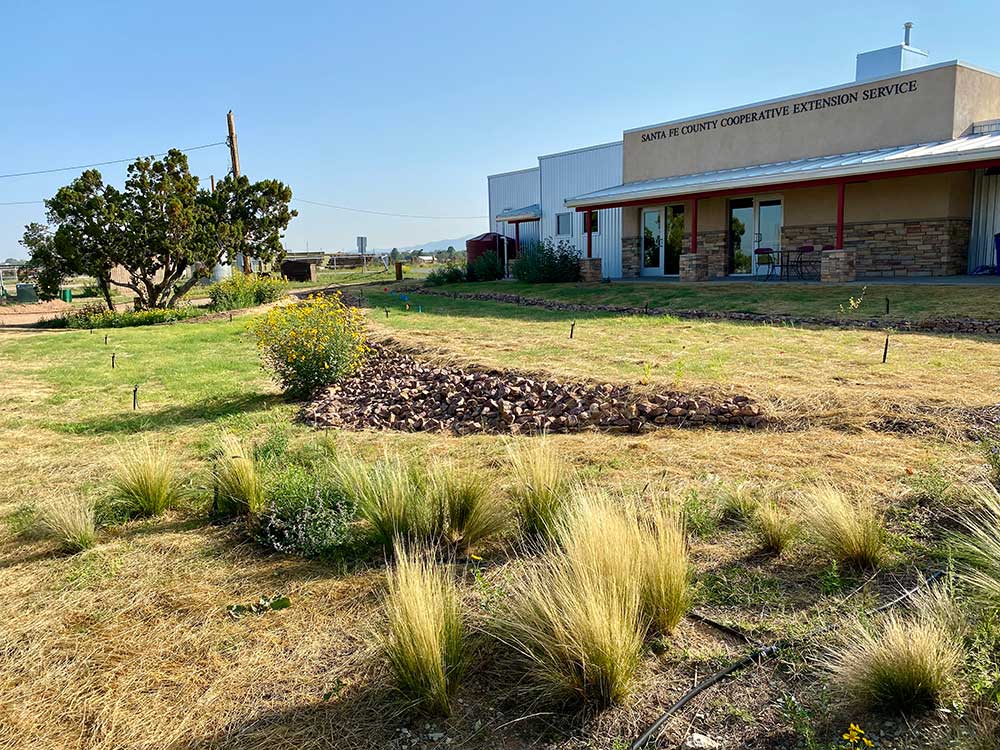How do you transform a parcel of compacted, nutrient-poor soil, populated sparsely by weeds, into a thriving garden of low-water native plants? You may find the answer at the Native Plant Demonstration Gardens that the Santa Fe Native Plant Project (SNaPP), a Santa Fe Extension Master Gardeners program that promotes the use of native plants in the local landscape, is creating.
The gardens, which are open to the public, are located at the Santa Fe County Extension Office, 3229 Rodeo Road, at the Santa Fe County Fairgrounds.
Several years ago, the Master Gardeners program developed a xeric demonstration garden in front of the office. When the building was remodeled in 2018, that garden was destroyed. Tom Dominguez, New Mexico State University’s Santa Fe County Extension agriculture agent who works at the office, agreed to serve as project adviser for a new low-water native plant demonstration garden that SNaPP’s project leaders, Helena van Heiningen and Joy Mandelbaum, proposed to cultivate in the old garden’s place.
Pam Wolfe and Lesley Mansfield, SNaPP’s current co-leaders, expanded the project to the west on reclaimed grassland, and east to create a pollinator patch. A retired statistician, Wolfe sees the garden as a rich “opportunity for experimentation.”
The Santa Fe Extension Master Gardeners program, Friends of Santa Fe Master Gardeners and New Mexico Native Plant Society have provided funding. With the collaboration of landscape professionals and volunteers, the gardens finally took shape in spring 2021.

The south garden is to the right of the office’s entrance. Master Gardeners program volunteers planted a cover crop of hairy vetch and winter rye, and the garden now welcomes employees and visitors with a mélange of native plants, including volunteers from the existing seed bank, that captivate the senses. Spring and summer – when gold, orange, scarlet, amethyst, mauve and white flowers abound – are particularly colorful. Visitors may also spot native bees, hummingbirds, and even a rabbit who enjoys breakfasting at the garden. Plants include golden crownbeard, licorice mint hyssop, spectacle pod and a small desert willow known for its fragrant, orchid-like flowers.
To the west is a reclaimed grassland sloping from the office’s porch to an induced meander that channels storm runoff from the upper parking lot and excess rainwater from three cisterns. Aligned with the goals of the New Mexico Healthy Soil Act of 2019, it’s inspired in part, Dominguez said, by improvements made to certain New Mexican ranches and forests to improve soil health. San Isidro Permaculture advised on reshaping the slope into three terraces edged by armored berms that volunteers built. By slowing and redirecting water, these features improve infiltration and reduce erosion. The parking lot runoff eventually reaches the meander, which Cullen Hallmark, leader of the Cactus Demonstration Garden, created from a ditch below a culvert.
To prepare the soil itself for seeding, Madrid Engineering, LLC surveyed and shaped the terraces and ripped them with a chisel plow. Volunteers incorporated 34 cubic yards of biosolids compost purchased from the city’s Wastewater Management Division, installed a temporary irrigation system, scattered seeds for native grasses and forbs and covered the seedbed with blue grama hay and a mulch binder. Within days the seeds began to germinate, and the new grassland emerged.
This landscape is an example of Plains-Mesa Grassland, which ranges over large parts of eastern and central New Mexico. The dominant grass is blue grama, New Mexico’s state grass. A perennial, warm-season grass with fine leaves and blue-green seedheads, it’s drought-resistant, cold-hardy, and tolerant of poor soil. And it provides habitat and food for numerous animal species. Other grass species at the gardens include galleta, Indian ricegrass and western wheatgrass.
Volunteers seeded the pollinator patch to the east with a similar mix, but with a higher proportion of wildflowers. It also features plants from a low-water pollinator habitat kit the Xerces Society for Invertebrate Conservation distributed free to residents and local organizations in Santa Fe in September. Plants from the society’s low-to-medium water kit were placed in swales and spillways on the west side. Each kit included 33 native plants attractive to pollinators, including perennial wildflowers and a New Mexico olive or three-leaf sumac.
Wolfe describes the project as a “living classroom” that will host programs on native plants, soil testing, beneficial insects and other subjects. She also hopes the progress made so far will inspire more reclamation and restoration efforts in the long term.
The original version of this article was published in the November 2021 issue of the Santa Fe Extension Master Gardeners newsletter.
This article was posted by Cheryl Fallstead














